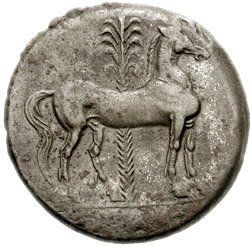Carthage Trihemishekel
Introduction
The Carthage Trihemishekel, a 1½ Shekel billon coin, holds a significant place in ancient numismatics. Issued by Carthage, this coin showcases exquisite design elements that reflect the cultural and historical context of its time.
Historical Background
Carthage, a prominent ancient city-state in North Africa, was known for its maritime power and trade dominance in the Mediterranean. The issuance of the Trihemishekel coin by Carthage signifies its economic prowess and influence in the region. This coin circulated during a period of great prosperity and commercial activity for Carthage.
Coin Images
 Obverse
Obverse
 Reverse
Reverse
Design Features
The obverse of the coin features the iconic image of Tanit, the Phoenician and Carthaginian goddess of love and fertility. Tanit is depicted facing left, adorned with a wreath of corn, a necklace, and a single-drop ear-ring, symbolizing prosperity and abundance. The reverse side showcases a majestic horse standing to the right, with a palmtree in the background, representing strength, wealth, and vitality.
Technical Specifications
The Carthage Trihemishekel coin has a weight of 10.70 grams and a diameter of 26.00mm. Crafted from billon, a mixture of silver and base metals, this coin exemplifies the ancient metallurgical techniques employed by Carthaginian mints. The intricate details on both the obverse and reverse designs reflect the skilled craftsmanship of the minting process.
Collectible Value
Due to its historical significance and intricate design, the Carthage Trihemishekel coin holds a high collectible value among numismatists. Its rarity and unique cultural symbolism make it a sought-after piece for coin collectors and enthusiasts. The market value of this coin may vary based on its condition, historical provenance, and demand in the numismatic market.
Conclusion
In conclusion, the Carthage Trihemishekel 1½ Shekel coin stands as a remarkable testament to the rich history and artistic achievements of Carthage. Its unique design elements and historical context make it a prized possession for collectors interested in ancient coins. Owning a piece of Carthaginian numismatic history not only adds value to a collection but also provides a glimpse into the cultural legacy of one of the ancient world's most influential civilizations.

